
enables nerve cells to regrow How siblings Ricarda and Florian inspire strength and hope in each other



enables nerve cells to regrow How siblings Ricarda and Florian inspire strength and hope in each other

The SCI Trials Finder helps people to easily locate, understand and participate in clinical trials that fit their situation. And it helps scientists to find suitable patients for their trial.
Trials carefully curated
Written in common language
Easy to use and mobile optimized
Seemless contact to trial locations
Instant notification of new trials
Metadata of all trials
Proudly
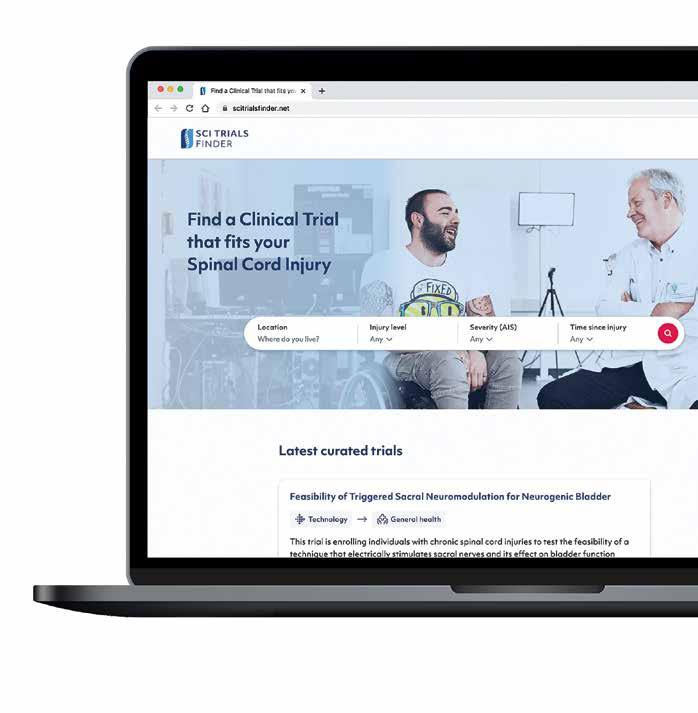


Wings for Life International Spinal
Cord Research Foundation
Fürstenallee 4, 5020 Salzburg, Austria
Phone: +43-662-6582-4244
Email: office@wingsforlife.com
Company Registration: FN 251592p
Legal Form:
Private non-profit foundation Register Court: Landesgericht Salzburg (Jurisdiction)
Chief Executive Officer:
Anita Gerhardter
Wings for Life United Kingdom: Seven Dials Warehouse 42–56 Earlham Street London WC2H 9LA
Great Britain
UK Registered Charity No: 1138804
Wings for Life USA: Spinal Cord Research Foundation Inc.
1630 Stewart Street, Santa Monica, 90404, CA 501 c3 Charity
Editors: Christina Herbst, Stefanie Schwarz, Denise Siebke
Contributors: Markus Böttinger, Ella Dodd, Lara Goritschnig, Sonja Kraus, Annelise Kerrison, Verena May, Brandon Peters, Beatrice Sandner
CEOs Red Bull Media House
Publishing:
Dietmar Otti, Christopher Reindl, Marcus Weber
General Manager Red Bull Media House Publishing: Stefan Ebner
Head of Co-Publishing & Project Management: Jennifer Silberschneider
Art Director: Simone Fischer
Graphic Designer: Andreea Gschwandtner
Photo Editor: Pinar Dagdevir-Winkler
Lithography: Nenad Isailovic
Translation: Manfred Thurner
Producer: Sabine Wessig
Acknowledgement:
We would like to express our gratitude to Red Bull Media House for producing this magazine free of charge.

By launching the Wings for Life Foundation more than 20 years ago, we triggered a chain reaction in spinal cord research. Today, we sense this momentum more acutely than ever: a steadily increasing number of brilliant scientists from all over the world are submitting their innovative research proposals to us.
One of them is Dr. Monica Perez. Her research into a new compound could not only represent a breakthrough in research but also provide new hope for patients (page 40).
None of this would be possible without you, our fantastic backers. Starting on page 6, we look back at our fundraising highlights –and at a very special running event that conjures a smile on our faces every year: the Wings for Life World Run (page 46).
Together we will make spinal cord injury curable – thank you from the bottom of our hearts for joining us on this journey.
Enjoy your read, Your Wings for Life Team

Greatest
35 Top Donor on a Mission
Menno Streefland sells back protectors to support spinal cord research 70 Meet with Ease
How do you interact with people who have a spinal cord injury? Wolfgang Illek shares useful pointers from the perspective of someone affected
30 The Scientific Meeting Six highlights from our scientific symposium in Salzburg
NVG-291 – a New Hope
A new compound enables nerve cells to regrow
The Pioneer of Electrostimulation
A final conversation with the exceptional researcher Milan Dimitrijevic (1931–2025)

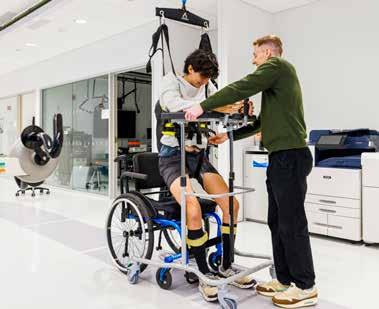


Our ultimate ambition is to find a cure for spinal cord injuries. Every valuable donation we receive brings us one step closer to this goal.
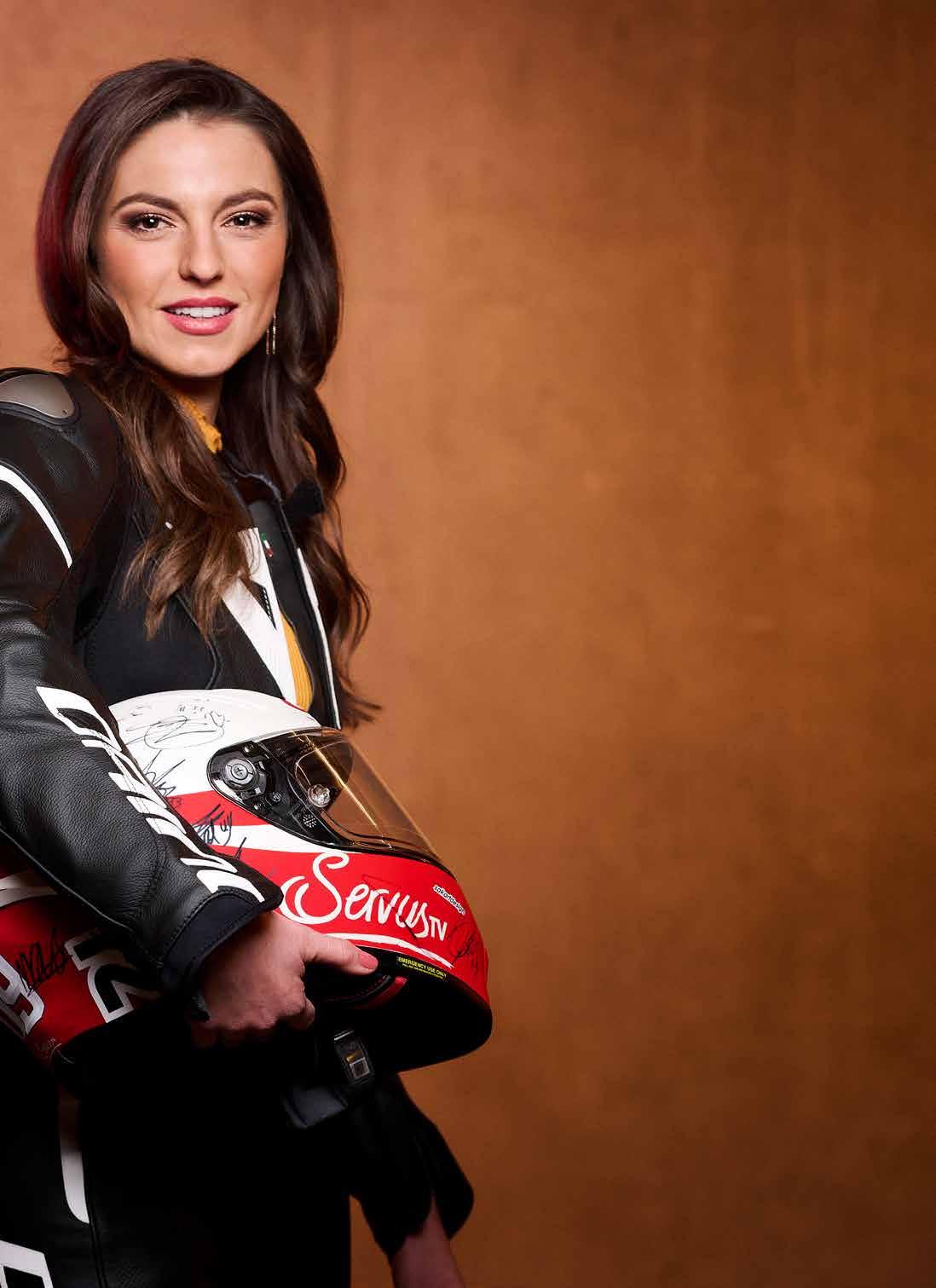
We can look back on an extraordinary fundraising campaign with pride. ServusTV, primarily through presenters Andrea Schlager and Alina Marzi, worked tirelessly to collect signatures from all MotoGP and Formula 1 drivers of the 2024 season on two unique helmets. These exclusive one-offs were entered into a charity raffle that attracted more than 12,000 supporters. The result: a record sum of 256,000 Euros in support of Wings for Life.

In 2017, a diving accident left Ed Jackson severely injured with an incomplete spinal cord injury.


Great Britain
He was told he would never walk again. Through life-saving surgery and relentless physiotherapy, he gradually regained minimal movement, starting with a twitching toe, eventually progressing to standing and walking. Ed now suffers from Brown-Séquard Syndrome, a neurological condition that results in weakness or paralysis on one side of the body and loss of sensation on the other. However, Ed hasn’t let this hold him back. At the London Marathon, he teamed up with his friend Ross Stirling to run a three-legged race by tying his “bad leg” to Ross’ leg. While tied together for a cure, they also wore iconic white wings to raise awareness for Wings for Life. “Wings for Life is important to me because it gives hope to millions living with spinal cord injuries. Running a marathon three-legged with Ross was a bit ridiculous, but if it helps move that research forward, then every stumble and every bit of Vaseline was worth it!” Ed smiles. They crossed the finish line after 9.5 hours – and were able to raise over £ 8,000 for spinal cord research.

The XX: from 0 to 1 Million 20 committed supporters came together in Salzburg to mark the 20th anniversary of Wings for Life by raising 1 million British Pounds for Wings for Life and cutting-edge research over the course of one memorable day. During The XX, one highlight followed another: highspeed laps in the Valkyrie super sports car with racing legend David Coulthard at the wheel, a dinner at the two-star Michelin restaurant Ikarus in Red Bull Hangar-7, and a private flight over the Austrian Alps in the historic DC-6.
One Mission. Two Unforgettable Events. Against a backdrop of sweeping desert horizons and a sky painted in twilight hues, two remarkable gatherings came to life in Scottsdale, Arizona. The Wings for Life Golf Classic united golfers for impact at the iconic TPC Scottsdale, and as the sun dipped below the mountains, The Cord Club Scottsdale elevated the evening with purpose. Combined, these incredible events raised an impressive $ 1,379,000 for spinal cord injury research. Together, these moments built a legacy of hope and progress.

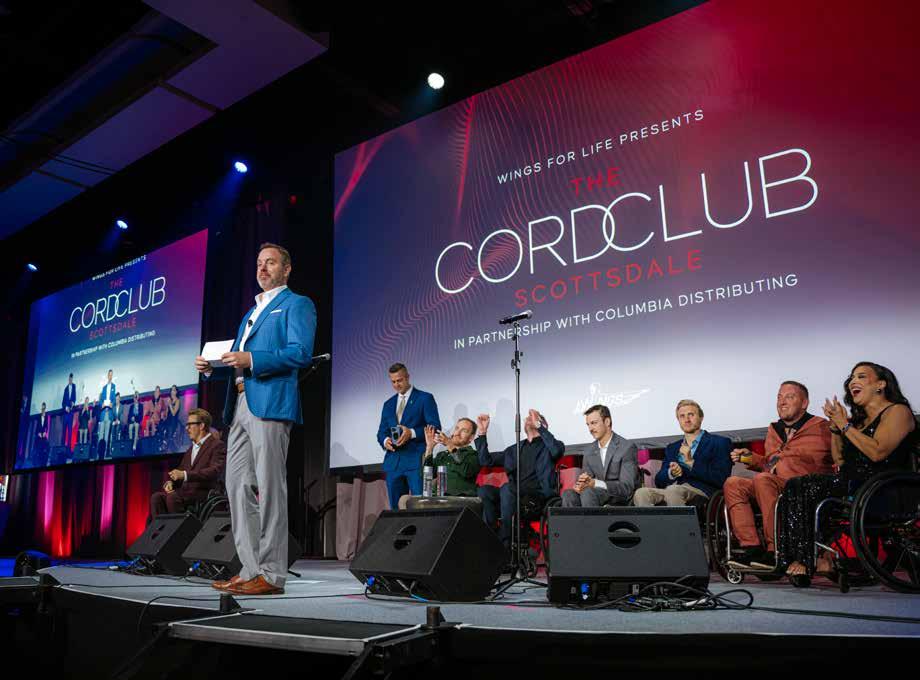
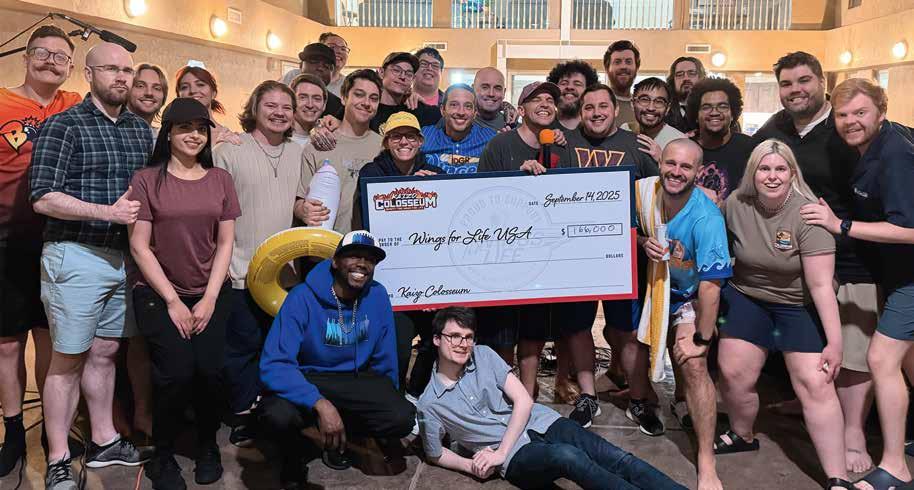


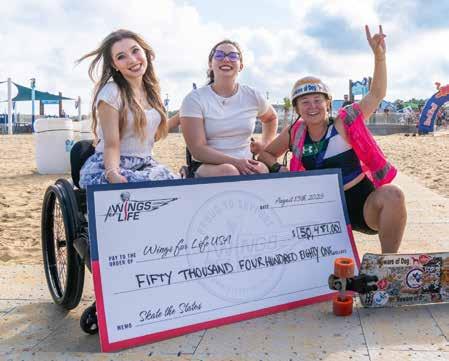

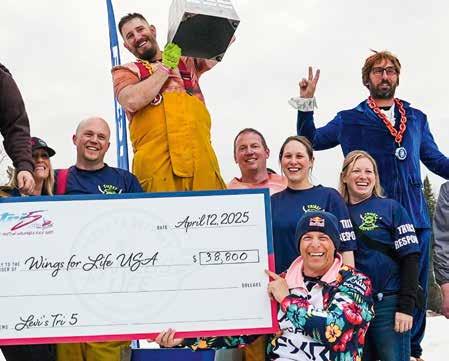

“
Ricarda and Florian are siblings who provide each other with the utmost support. A compelling story about two individuals, their pursuit of happiness, and an unfaltering hope.
Seeing my little brother in the ICU for the first time was a horrific experience. I remember the cables, the drips, and the wounds all over his body. His face was all swollen.” Ricarda is 35 years old. Recalling the events of ten years ago, she reflects calmly on a time that would also change her life fundamentally. Florian is sitting next to her, in his wheelchair. He listens attentively to what Ricarda has to say before adding to her account. “All because of that one moment.”
In 2015, Florian was 20 years old, had successfully completed his apprenticeship as an electrician, and had started another as a metalworker. His passion, however, was his involvement with the volunteer fire brigade. “Helping others was my greatest motivation,” he says. “I also spent a great deal of time in the mountains, such as on that particular Friday in autumn.”
Florian and a friend set off at 4am and reached the summit of the Hütteltalkopf, near Krimml in
Austria, standing at almost 3,000 meters, at 11am. “The day couldn’t have seemed more perfect,” the Salzburg native recounts wistfully. During the descent, he lost his footing on an icy patch and tumbled 270 meters down the mountain. “When I had finally checked my fall, I tried to move. I couldn’t.” Florian assumed he was in shock and just needed a few moments to catch his breath before standing up and continuing on his way. “My friend called down to me that a helicopter was on its way, which


Special childhood memories: Florian and his older sister Ricarda during one of their many family hikes. Even today, they still enjoy spending time together in nature.
seemed completely over the top to me at the time.” As a volunteer firefighter, Florian understood the potential severity of his injury. “I simply couldn’t face up to it, though.”
The young man was safely rescued, airlifted to a hospital in Innsbruck, and promptly underwent surgery. His vertebrae were displaced at the 6th and 7th level of his cervical, his spinal cord severed. The team in the operating theatre soon realized that the then 20-year-old had suffered a
high-level spinal cord injury. Ricarda remembers fearing for her brother. “I still can’t find words to describe the moment when my dad finally called me with the diagnosis. It felt like the ground had suddenly disappeared from under my feet. I couldn’t imagine anything worse…”
“This Is Not the End of the Story”
When Ricarda saw her brother in the ICU for the first time after the accident, she hardly recognized
“When I had finally checked my fall, I tried to move. I couldn’t.”
Florian Lechner
him. Florian recalls: “I was placed in an induced coma for a week. When I slowly came to and realized what had happened to me, I refused to accept my fate. It felt like my legs weren’t there anymore because I had lost all sensation in them, but I also thought that it wouldn’t stay that way. I was convinced that this wasn’t the end of the story.”
After months in hospital, Florian was referred to a rehab center in Bad Häring, Tyrol, and was introduced to new routines in a wheelchair. “I couldn’t – and still can’t – move or feel my body from the collarbone down. That changed everything,” he explains. Ricarda smiles at him. “Yet you returned to a positive mindset pretty quickly.”


“I may no longer be able to wield a screwdriver, but I enjoy using my mind and have since started working as a planner.”
Florian Lechner


The siblings began planning a renovation, because at that point, their parents’ home was anything but barrier-free. When construction finally got underway, the world came to a standstill once more. “Sadly, our dad took his own life. I can’t really explain why, but it seems it was all too much for him,” says Florian. The family was showered with support in their time of grief. Six months later, the barrier-free apartment was ready. “Returning home was difficult for me. I can’t move my fingers, which is probably the worst aspect of my day-to-day life. On top of my physical limitations, our dad was suddenly no longer around either…”
Ricarda and Florian supported each other and became each other’s greatest source of strength.
“Mum took over my care, and Ricarda was always there for me. We spent a great deal of time together as I finally started getting out of the house more often to enjoy nature.” Florian decided to qualify as a master electrician. “I may no longer be able to wield a screwdriver, but I enjoy using my mind and have since started working as a planner.”
What Florian regrets most is that he can no longer serve as a firefighter. “Hearing the sirens still stirs up memories. I can feel the adrenaline coursing through my veins, and I just want to help. Instead, I am forced to sit at home and do nothing.” Ricarda agrees with her brother: “I can see how this feeling of powerlessness tears at your heart.”

“When I wake up, I often think to myself: not today. Please gift me a single day without a spinal cord injury.”
Florian Lechner
To improve his long-term outlook, Florian is attending regular therapy sessions and investing a considerable amount of time in organizing and promoting a Wings for Life World Run App Run Event. “I first discovered the Wings for Life World Run on TV while in rehab. The idea captured my imagination and has stayed with me ever since.” The whole world comes
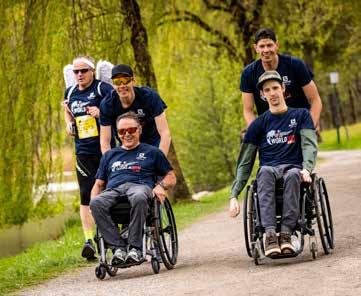

together to run for spinal cord research at the same time. “It gave me such a boost at the time. A few years later, we co-organized our own run.” Their App Run Event in Saalfelden is becoming more popular every year. “It’s always a very special and positive day for us.”
The siblings are unwavering in their hope for a cure. “I just wish I could regain a little feeling or a few abilities. Even the smallest improvement would mean the world to me.” Ricarda adds: “My wish for you is that you can stand up and walk again. You’re so tall –almost two meters – and I would like to look up to you again.” Florian nods: “I just want to be able to
move around independently again, without help. When I wake up, I often think to myself: not today. Please gift me a single day without a spinal cord injury.” Ricarda is visibly moved. “That’s what we hold onto. And until then, we’ll be there for each other.”
Either at one of the Flagship Run Events or worldwide via the app. 100% of all proceeds are invested in spinal cord research. For more information, please visit wingsforlifeworldrun.com.

For more than 20 years, Red Bull Hangar-7 at Salzburg Airport has been an institution in the city of Salzburg—a landmark and architectural highlight, an exciting excursion destination, and a culinary think tank. The concept? To create a place where art, cuisine, and a love of aviation come together in an inspiring symbiosis. The wing-shaped structure made of glass and steel has become a landing spot for international top chefs and, in addition to housing the historic fleet of The Flying Bulls, also features many other exhibits from the Red Bull universe as well as regularly changing exhibitions of contemporary art.
Hannes Kinigadner suffered a spinal cord injury during a motocross accident. His father Heinz Kinigadner founded the Wings for Life Foundation together with Dietrich Mateschitz.

GETTING UP WHENEVER I WANT

Heartfelt dreams, high hopes, and a shared journey towards finding a cure.
“The first thing I would do if there was a cure tomorrow is get up and give someone a proper hug. Probably my mom.”

In 2010, Steph Aiello sustained a spinal cord injury in a car accident after falling asleep at the wheel. She is now a vocal advocate for the SCI community, as well as a model and influencer.
Professor Jan Schwab is a neurologist and physician-scientist at Ohio State University, co-founding member and Scientific Director of Wings for Life. He discovered immune dysfunctions that can hinder neurological recovery.

“We hold the potential to significantly improve treatment outcomes for patients suffering from spinal cord injuries in the near future.”
“A cure would give me more than I could ever dream of. To be able to grab my daughter and pick her up myself. That would be living life to its fullest.”
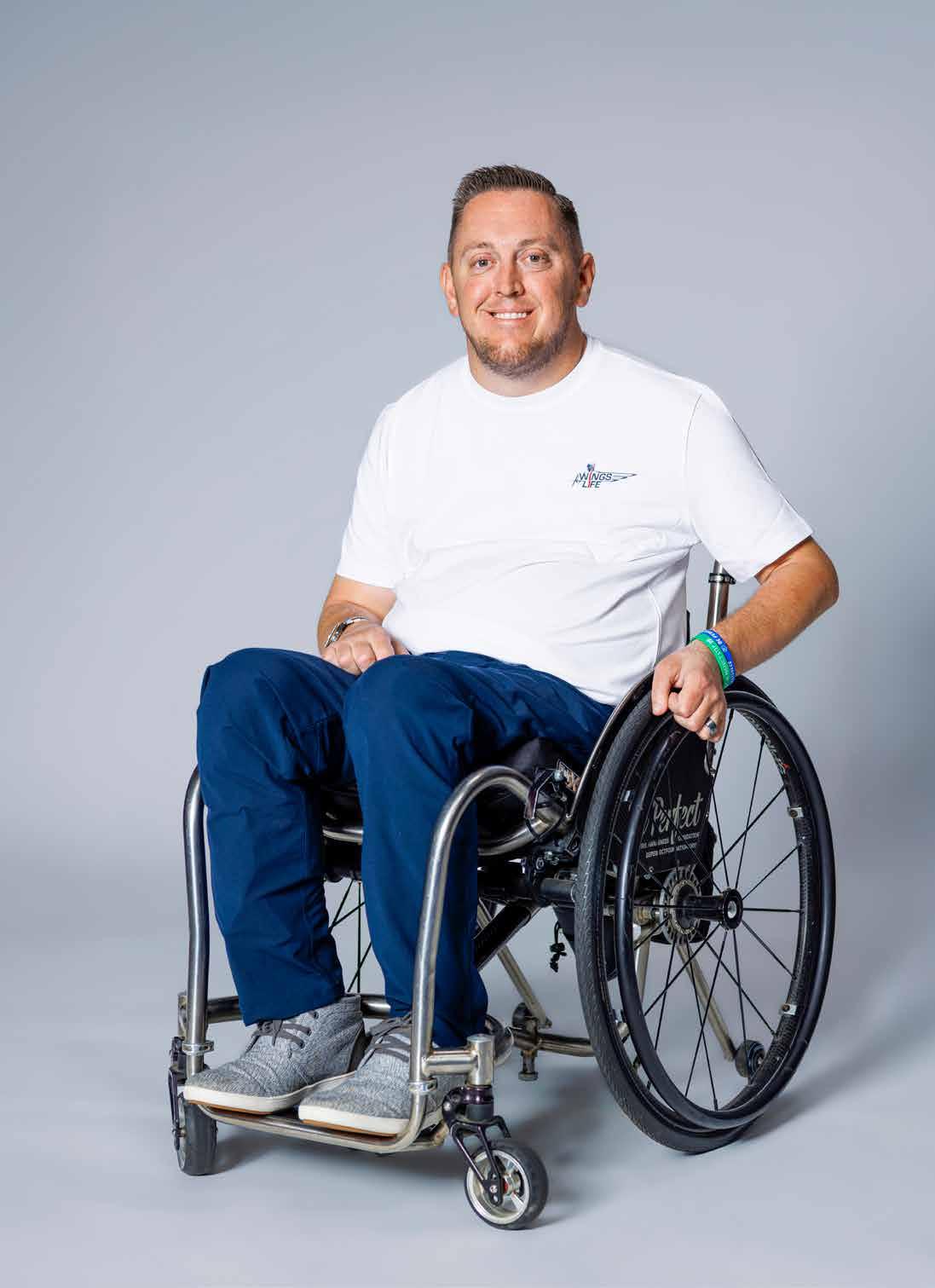
was 17 when his semitruck lost control and flipped four times. Since then, he has dedicated his life to supporting people impacted by paralysis and advancing spinal cord injury research.
Dr. Verena May holds the position of Executive Director Research Portfolio at Wings for Life. She is an important point of contact for researchers from all over the world and plays a key role in ensuring that donations are deployed prudently and effectively.

“It’s no longer a question of whether there will be a cure, but when.”
“When we find a cure, I will one day walk my daughter down the aisle. Hand in hand.”

cord.
At 20, Aaron Baker was paralyzed in a motorcycle crash and given a onein-a-million chance of recovery. Defying those odds, today he inspires much hope for healing the injured spinal
“We support numerous important research projects. Every single one represents a crucial piece of the puzzle on the path to curing spinal cord injuries.”
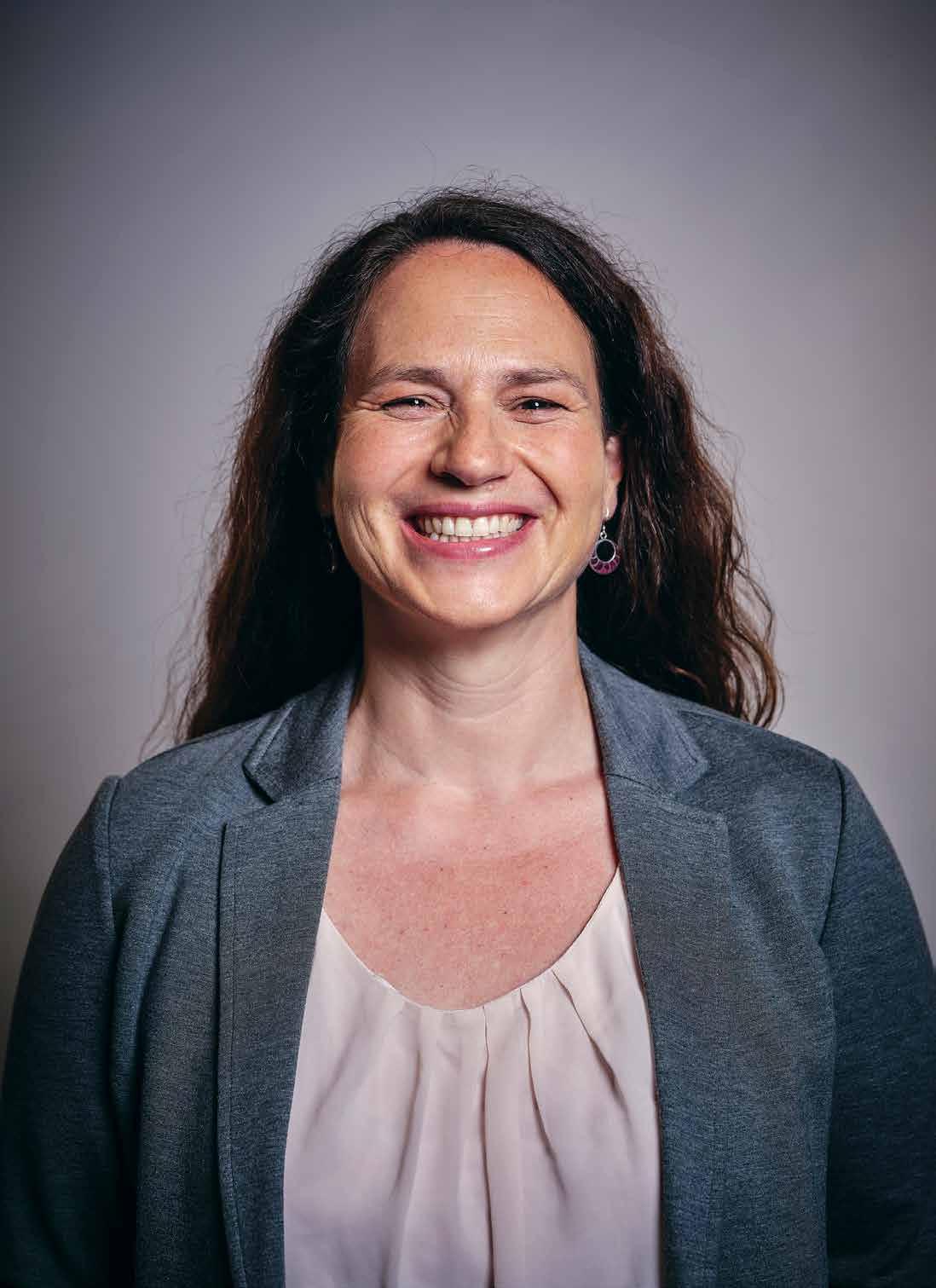
Dr. Beatrice Sandner is a neuroscientist and Research Portfolio Manager at Wings for Life. She specializes in the regenerative capacity of neural stem cells and cell-based therapeutic approaches.

Our annual Scientific Meeting attracts the leading minds in neuroscience to Salzburg.
WE’D LIKE TO SHARE SOME OF THE HIGHLIGHTS WITH YOU.
This year, 112 scientists came together to pursue a common goal: finding a cure for spinal cord injury. The Red Bull Arena, usually a setting for exciting football matches, transformed into a stage for scientific dialogue. In both sport and research, it requires team spirit, perseverance, and passion to achieve ambitious goals. Every contribution is important –yet only teamwork results in scientific breakthroughs capable of securing victory.


Participants from 15 countries –including the U.S., Canada, Uruguay, Japan, Germany, and France – gathered in Salzburg, Austria, this year, turning the town into the hub of the international scientific community. Researchers from renowned institutes such as Charité Berlin, the University of Massachusetts, and Yale University ensured an exchange of high-caliber ideas.

One aspect that makes the Scientific Meeting so unique is that participants present research findings that nobody outside the conference is aware of yet. From innovative basic research to clinical studies – the variety of topics demonstrated how dynamic this field of research is. A total of 59 projects were featured, 23 as live presentations on stage and 36 as poster submissions. Even during coffee breaks and the group barbecue in the evening, the main focus was always on exchanging views on current projects.

Three minutes – that’s how long the Data Blitz gives scientists to present their projects: fast, concise, to the point. The compact format provided a brief overview of current developments. The studies were then discussed in detail during the subsequent poster sessions.
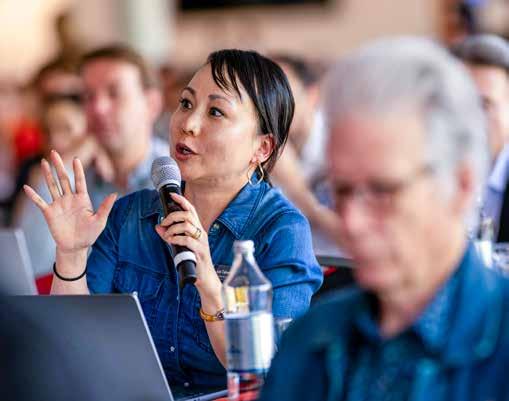
Young scientists also took the spotlight. Charlotte Decourt, a postdoctoral researcher at Imperial College London, was awarded the poster prize for her contribution on the role the liver plays in wound healing.
“I am immensely grateful for this recognition.”
Prof. Milan Dimitrijevic

The recognition of Professor Milan Dimitrijevic (1931–2025) for his life’s work was a particularly moving moment. In her laudatory speech, Dr. Monica Perez paid tribute to his pioneering spirit. When Hannes and Heinz Kinigadner presented the award, the auditorium fell silent. After all, it was Professor Dimitrijevic who was among the first to offer Hannes hope after his accident. His research continues to inspire today (more on page 48).


Every success story has an origin. In Menno Streefland’s case, it began with a personal disaster.

Menno skiing in Austria – before the accident happened.
Three years ago, the Dutchman was skiing in the Zillertal Arena when he veered off the prepared slope and skidded ten meters through rough terrain. The accident left him severely injured. Once he had been rescued, the attending doctors diagnosed a spinal cord injury. “No two injuries of this kind are the same. I consider myself privileged that my spinal
cord was not completely damaged, meaning that I retained some bodily functions,” the 30-year-old explains during a visit to the Wings for Life foundation in Salzburg.
Today, Menno is capable of walking short distances, not least due to intense training regimes. “I still struggle to keep my balance, which
Menno has an incomplete spinal cord injury – he can walk short distances without a wheelchair, using a walking aid.

“I hope my situation continues to improve, and that a cure is found soon for the countless others in a similar situation.”
Menno Streefland


is why I use my wheelchair for distances exceeding 500 meters. Unfortunately, many buildings in the Netherlands are not barrier-free –and toilets are almost always located up or down a flight of stairs.”
Menno is proud of his achievements despite the hurdles he faces on a daily basis. “My friendships, as well as my relationships with my family and girlfriend, have not been affected. Yes, my body has changed, but I am still the same guy I was three years ago.”
Menno has bigger plans. “After my accident, I launched a range of back protectors that are now selling
highly successfully. spines are designed to protect people participating in sports, to spare them the same fate as mine.” And there’s more: “Every unit sold results in a donation of 15 Euros to Wings for Life,” Menno explains. With his amazing initiative, the young Dutchman has already managed to raise 150,000 Euros for spinal cord research. “I hope my situation continues to improve, and that a cure is found soon for the countless others in a similar situation.”
and all details about his back protectors are available at www.spines.nl.
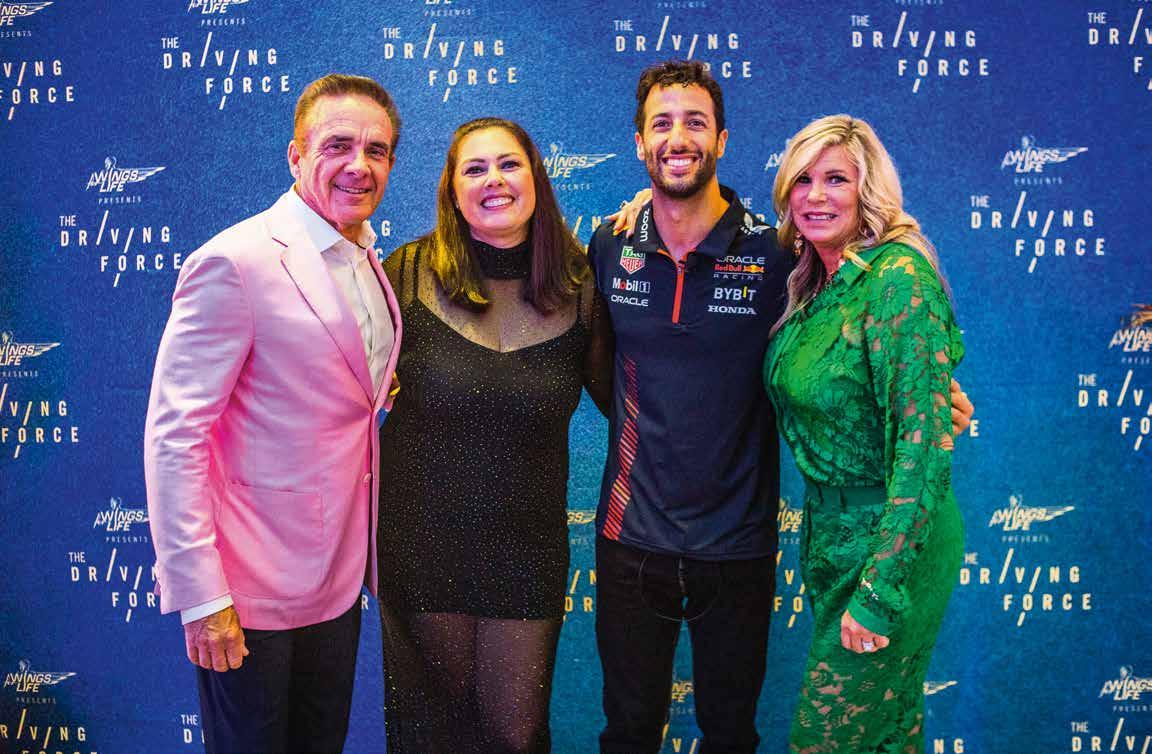

Researchers in the U.S. are currently investigating a compound that could mark a breakthrough –and bring new hope to millions of people.

„I was in the back seat when we veered off the road and smashed into a telephone pole.“
Niko Paskos
Wheelchairs hum softly while traversing the floor. Walking aids clatter as muffled voices fill the light-flooded rooms. The Shirley Ryan AbilityLab in Chicago is a source of hope. Here, Dr. Monica Perez and her team are testing a compound that could make the impossible possible: to stimulate nerve cells to regenerate after spinal cord injury. The name of this new hope is NVG-291 . Its effect has the potential to change lives. “Our field of research has already witnessed many clinical studies. However, this approach, which aims to regenerate neurons and promote their growth, is something quite unique,” the study principal investigator explains.
The spinal cord resembles an information highway on which signals travel back and forth between the brain and the body. In the event of an injury, this route is blocked, and nerves cannot re-establish connections. Scar tissue that forms at the site of the injury prevents the nerve fibers from regenerating. Some approaches focus on breaking down the growth-inhibiting substances in this scar tissue. Yet Dr. Monica Perez and the company NervGen Pharma Corp are pursuing a different approach. Instead of attacking the inhibitors directly, they target their docking site, the so-called sigma receptor, which serves as a
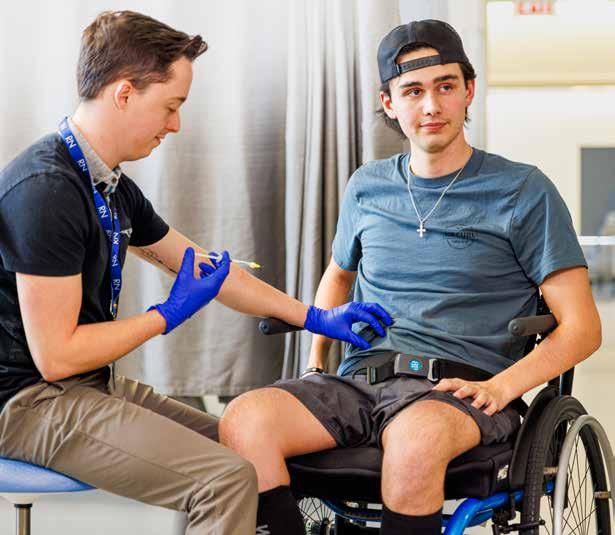
The compound is injected directly under the patient's skin.
kind of control center within the scar tissue. This is where NVG291 comes into play. This novel substance is injected subcutaneously. It is designed to render the scar tissue permeable and stimulate damaged nerves to regenerate and form new connections. The special feature: NVG-291 addresses the cause of the damage, not merely the symptoms.
Research into this approach dates back to the 1990s, to the laboratory of US neuroscientist Prof. Jerry Silver. He was the first to describe how scar tissue covering the injury site prevents nerves from regrowing – an insight that changed our understanding of spinal cord

The so-called GRASSP test is used to assess the gripping movements of hands and fingers.
The clinical study is being conducted at the Shirley Ryan AbilityLab in Chicago, USA.

injuries forever. Dr. Monica Perez has made it her mission to translate this groundbreaking discovery into an effective treatment. “I draw inspiration from my patients. We still have no cure, no approved treatment. Our NervGen study aims to close this gap,” says the Chilean-born researcher, who has been working in spinal cord research for more than 20 years.
So, what does this research imply for people whose lives have been upended by a spinal cord injury?
One of them is Niko Paskos, a participant in the NervGen trial. For him, the success of the compound could change literally everything.
The 20-year-old American had just returned home from college in Hawaii for the holidays when his life took a dramatic turn.
“I remember feeling like anything was possible. I was ready to conquer the world, went surfing or running every day, and enjoyed being physically active,” Niko muses. Until the accident happened.
He was traveling with friends on a rainy evening: “I was in the back seat when we veered off the road and smashed into a telephone pole.” Niko regained consciousness four days later. The diagnosis: a severe concussion, numerous broken bones, and an incomplete spinal cord injury at level C7, in the lower portion of the cervical spine. “I was hooked up to a ventilator and unable to speak. I just lay there while the doctors explained my condition. No manual tells you how to deal with news like that.”
Niko had no idea what to expect next. The doctors reckoned he might never be able to walk again.
„I draw inspiration from my patients. We still have no cure, no approved treatment. Our NervGen study aims to close this gap.“
Dr. Monica Perez
“The first few weeks after my injury were particularly tough,” the Texan recalls. Niko needed help with everything – to get out of bed, take a shower, or use the toilet. He spent a great deal of time in rehabilitation in the vague hope that some bodily functions would return.
“Given my injury level, my hands and fingers are affected in particular.” Little tasks, such as closing a zip, turning a doorknob, or pulling a wallet out of his trousers, are incredibly difficult for Niko. NVG-291 is designed specifically for people like him. “We screen patients suffering from cervical spinal cord injuries, meaning that both arms and legs are affected. These individuals struggle with reaching for things – but their legs, and therefore their mobility, are also impaired,” explains Dr. Perez. Despite such challenges, Niko re-
mains optimistic: “I feel incredibly privileged to be part of this ground-breaking research and cannot wait to see where it leads. Deep down, I truly believe that this treatment will change the lives of millions of people.”
The journey from initial laboratory research to the clinical trial, with the first patient enrolled in 2023, has been a lengthy one. Even though the results are preliminary and further research is required, the early signs of improved hand function are impressive. Progress has been made even in patients whose injury was sustained years ago. This proves that functional improvements are possible even long after an injury.
Another part of the NervGen study is analyzing the effect of

treatment in the acute phase, i.e. a few days after the injury, on regeneration. It is also conceivable that this treatment could improve leg function in the future. If successful, this would not only represent a medical breakthrough for many affected patients but could be a real glimmer of hope for a new life without restrictions.
As Niko Paskos himself explains: “If this study is successful, the very first thing I will do is run to the airport and hop on a plane to Hawaii. That is my plan. Who needs a car then? I would walk to the beach, run along the beach. I think I would never stop running.”
Wings for Life has actively supported the NervGen study and co-funded it with 3.8 million US dollars via the “Accelerated Translational Program”. Thank you for making projects like this possible with your donations and helping to find a cure for spinal cord injury.



One starting signal, millions of steps – and a day that instills unlimited hope.
THIS IS THE WINGS FOR LIFE WORLD RUN.

Global Race Control, Munich. 12.30pm. Monitors flicker, headsets click, the countdown begins. There are more than 200 people in identical shirts, with thousands more working hard around the globe. Only moments to go until the start of the Wings for Life World Run – the largest running event in the world. Alex Höller rubs his forehead as the tension mounts. After so many years serving as project manager, you might think he wouldn’t be feeling the nerves. Yet on this day, even he is affected by the magnitude of the task. “So many things can go wrong – you never know what could happen,” Höller explains.
It all began in 2014 with an idea: “It always annoyed me that the runners who finish last are overlooked.
Surely there had to be a way for the last to be first,” says Hello Haas, who is considered the creator of this event format. He met with Anita Gerhardter, CEO of Wings for Life, to pitch his idea. This signaled the birth of the Wings for Life World Run: “At its core, the World Run is pure madness – in terms of technology, logistics, and organizational matters. If I had anticipated the complexity of this project, I probably wouldn’t have had the courage to pursue it,” smiles Anita Gerhardter. Nevertheless, she was enthusiastic about the idea from the offset.
It was the first event of its kind, featuring a simultaneous start across the globe and without a conventional finish line. “The concept of the moving finish line is ingenious,” says Anita. Instead of running towards a finish line, everyone tries to outrun the catcher car for
The best day of the year: In 2025, 310,719 people participated in the Wings for Life World Run, raising an incredible 8.6 million Euros together.
“The concept of the moving finish line is ingenious.”
Anita Gerhardter
as long as possible. The latter departs 30 minutes after the start and overtakes the participants from the rear – as a physical car at the Flagship Run, or in virtual guise via the app. Those who are passed are at the finish line – and have invariably achieved their personal best. Pressure, pace, performance level – all secondary considerations. It doesn’t matter whether you’re in a wheelchair, enjoy a swift stroll, or decide to run flat out. The Wings for Life World Run is not about winning a race but about running for those who no longer can.
Sandile Mkhize is one of these people. He spent two years in hospital recovering from a motorbike accident. He underwent more than 30 surgical procedures and has been paralyzed ever since. The South African completely isolated him-

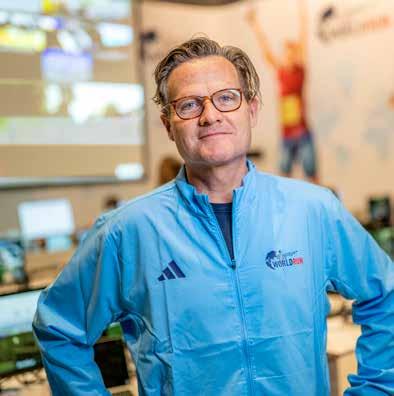



“I’m grateful for every single participant. I firmly believe that we will find a cure as long as we all do as much as we can to help. This event affords us a chance to make the world a better place.”
Sandile Mkhize
self at home at first, refusing to meet friends or family. “I was at a point in my life where I really didn’t want to be here anymore. I wanted to give up,” says Sandile. Everything changed when a therapist told him about a very special running event. A race in which the whole world runs to help finding a cure for spinal cord injury. That day, Sandile decided to fight. Participating offered Sandile a way back into life: “I’m grateful for every single participant. I firmly believe that we will find a cure as long as we all do as much as we can to help. 100% of the entry fee goes directly to spinal cord research. This event affords us a chance to make the world a better place.”
The WHO estimates that around 250,000 people suffer a spinal cord injury every year, roughly half of them as a result of road accidents. It can happen in the blink of an eye. This is where the Wings for Life Foundation steps in. All entry fees and donations generated by the Wings for Life World Run are channelled directly into research. This is made possible by Red Bull covering the event costs in full. “We invest every single Euro raised in promising research projects in an effort to support brilliant researchers,” explains Anita Gerhardter. More than 300 projects have been funded since the foundation was established. An increasing number of them are successfully progressing

to clinical application: “Some clinical studies are enabling patients to regain control of their leg muscles, and that really inspires hope.”
Back at Global Race Control, on a Sunday in May. The entire team is assembled in a large room as Alex Höller starts the day by addressing the Wings for Life staff. “The reason we’re all here is Hello Haas, who had the crazy idea of running away from a car,” Alex says. Laughter echoes around the room; you can sense the energy and anticipation. Everyone is getting ready to once more stage the largest run in the world. It is an event that represents so much more than a standard running competition. For those affected, like Florian Lechner, it is a day of genuine hope. He suffered a spinal cord injury in a mountaineering accident and is now organizing an App Run Event with his sister (read more on page 12): “You can feel the support. Everyone is running for a great cause, for people like me. It feels like a birthday and Christmas all rolled into one.”

“So many things can go wrong –you never know what could happen.”
Alex Höller

Alex Höller oversees the start of the Catcher Cars –worldwide and at the same time.
The next Wings for Life World Run takes place on May 10, 2026. You can participate anywhere: at one of the large Flagship Runs or via the Wings for Life World Run app. Either start directly from your own front door or join a regionally organized App Run Event. All the information on how to register is available at wingsforlifeworldrun.com
“Inside the Biggest Race” –Stream the documentary about the Wings for Life World Run here.
Spinal cord research mourns the loss of one of its defining figures: Milan Dimitrijevic, widely regarded as a pioneer of modern electrostimulation. We had the privilege of speaking with this exceptional researcher one final time.
Milan Dimitrijevic (1931–2025) was a neurologist, a neurophysiologist, and a true luminary in the world of spinal cord research.


A moving moment at the annual Scientific Meeting: Milan Dimitrijevic was honored for his life's work. In her laudatory speech, Dr. Monica Perez praised his pioneering spirit.
Professor Dimitrijevic, you have been shaping the field of neurology for half a century – what inspired you to embark on this journey?
I’ve been fascinated by the human nervous system from a young age. It governs movement and impacts the entire body. I’ve been particularly interested in the implications of neurological injuries. This curiosity drew me to medicine. My goal has always been to help people with neurological conditions, to improve their lives and their ability to move.
What were the greatest hurdles along the way?
The slow pace at which scientif
ic discoveries are translated into practical treatments was the most challenging aspect. Neurology is an incredibly complex field, and it takes years, sometimes decades, for new therapies to be thoroughly researched and tested. It is equally difficult to translate laboratory findings into clinical application, especially in the case of complex conditions such as spinal cord injuries.
That being said, to what extent has the field changed over the course of your career?
We have gradually improved our understanding of how the nervous system can adapt and recover fol
lowing an injury and how these changes can be utilized for healing, for example through cellular therapies. In particular, we are now better placed to understand how to specifically stimulate recovery after a spinal cord injury.
What were your most important findings during your research into spinal cord injury?
The most important finding during my research was in 1968. It was the discovery that electrostimulation can electronically control paralyzed extremities.
What is the crucial factor for the future success of such therapies?
The key factors are the patient’s residual functions and how these
are reorganized and processed. It is essential to start treatment as early as possible.
What role do foundations like Wings for Life play in spinal cord research?
They play a pivotal role in enabling research and advancing its application in practice. They promote collaboration, fund important research projects, raise public awareness, and facilitate the translation of innovations into clinical applications. In summary, they accelerate the development of breakthrough therapies for neurological conditions.
Your lifelong achievements were honored at this year’s Wings for Life Scientific Meeting. What does this honor mean to you on a personal level?
I am immensely grateful for this recognition. At the same time, I cannot help but think of the many people who have supported me throughout my career. It takes years, sometimes decades, to make a lasting contribution. It is so important to keep going and encourage others, despite all the obstacles.
Allow us to relay the most frequently asked – and most difficult to answer – question to you. Is there hope for people suffering from spinal cord injury?
Yes, there is hope. Progress requires time, but we have already made significant strides. We are already applying therapies that
“He inspired a great deal of hope in me.”
Hannes Kinigadner
Hannes Kinigadner and his father Heinz have first-hand experience of how much support Prof. Dimitrijevic has provided to those affected over the course of his career. They first met him in person after Hannes’ accident and his return from rehab in 2004 – a moment that instilled them with new courage. Heinz particularly remembers Prof Dimitrijevic’s remarkable commitment: “He travelled the world, tirelessly passing on his knowledge of electrical stimulation.”
He acted as an important pillar of support for Hannes Kinigadner after the accident: “He inspired a great deal of hope in me back then and was by my side during this difficult time.” Both are utterly convinced that, without Dimitrijevic’s pioneering work, the field of electrical stimulation would not be as advanced as it is today.
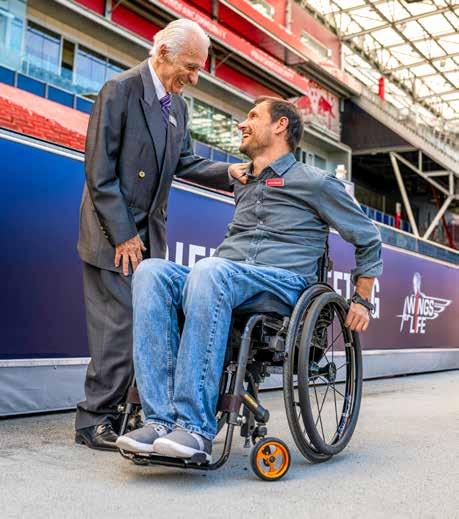
The native Serb dedicated his entire life to spinal cord research.

control spasticity and improve endurance when standing and walking. Research is underway to develop further approaches to generate functional movements. Even if full restoration of spinal cord function is not yet possible, progress is definitely being made – and we can expect further improvements in the future.
Do you have a life philosophy that characterizes your perspective?
I understand help as a relationship on an equal footing. Impairments often reveal hidden abilities that help us better understand the potential of affected individuals. It is
important to empower people with disabilities, ensuring that everyone can actively and positively contribute to society. An impairment does not inhibit growth, it opens up new paths.
What does Milan Dimitrijevic wish for the future as a private individual?
I hope that research will continue to deliver effective and accessible therapies for spinal cord injuries. I am particularly excited about the next generation of medical professionals and how people with spinal cord injuries will be able to reclaim as much of their pre-injury lives as possible in the future.
1931–2025
Prof. Milan R. Dimitrijevic was born in Niš, Yugoslavia, in 1931. He is considered among the pioneers of restorative neurology, the specialized field that focuses on the restoration of nerve functions. After studying medicine in Ljubljana, he obtained a doctorate in human neuroscience. His scientific career has been characterized by research residencies at renowned institutes such as Karolinska Institute in Stockholm and University College London. Professor Dimitrijevic headed the Division of Human Neurobiology



and Restorative Neurology at Baylor College of Medicine from 1987 to 1997, setting standards for the development of epidural spinal cord stimulation. This method, which activates functions of the spinal cord, formed the foundation for pioneering research by other renowned groups, including Susan Harkema, Grégoire Courtine, and others.
As early as 1995 and 1998, Prof. Dimitrijevic devised targeted
stimulation methods for muscles and lumbar spinal cord structures that are crucial for the ability to move the legs and pelvis – a real breakthrough in the treatment of motor disorders.
He will be remembered as a true luminary in his field, having published approximately 224 research reports, 190 articles in peer-reviewed journals, 56 chapters in neuro-rehabilitation books, and five edited books on restorative neurology.
Ilaria Palmisano, Ph.D., Neuroscientist and Assistant Professor at Ohio State University
Dr. Palmisano, what inspired you to become a researcher?
Deep curiosity and the thrill of discovery. I like the idea of uncovering something new, challenge existing beliefs, and expanding knowledge. Each new finding can open avenues for further explorations and innovation.
What fascinates you most about neuroscience?
The complexity of the nervous system and the firm belief that we have yet to uncover all its secrets.
Can you explain your current project in simple terms?
Spinal cord injuries can lead to permanent loss of movement and sensation because damaged nerve
fibers (axons) in the adult central nervous system cannot regenerate. One major reason for this is that neurons struggle to activate the genes needed for axon growth. Working with Prof. Di Giovanni, we discovered that the way DNA folds inside cells plays a crucial role in turning on these regenerative genes. In my lab, we are now investigating how to manipulate this 3D genomic structure to help neurons activate the right genes and promote axon regeneration. Our goal is to uncover new strategies that could lead to better treatments for spinal cord injuries in the future.
What continues to motivate you on challenging days?
Progress. I see challenges as a natural result of progress. The more we advance, the more we face complex problems – and with them, greater challenges. But the joy of overcoming these obstacles and the excitement of uncovering something new fuel my drive.
If you had one wish for the future of spinal cord research, what would it be?
That one day, we will no longer need research for spinal cord
injury – because we will have found a cure.
Was there a mentor or role model who particularly influenced your path?
All my teachers and supervisors have left a mark on me, contributing first to my education and later to my development as a scientist. However, the one who shaped my path the most was Simone Di Giovanni. I worked with him for ten years, and he was the most inspiring role model. He taught me to never be afraid of unconventional ideas.
Are there any milestones you are particularly proud of?
Yes, from key discoveries in my research to establishing my own lab, each of them has been a meaningful achievement.
How do you wind down after a long day at work?
I enjoy reading novels and training in Kung Fu. I also recently started classic ballet dance!
Do you have a personal mantra or philosophy?
Enjoy what you are doing. Do what you enjoy.

Ilaria Palmisano
Scientists around the globe are working tirelessly to find a cure for spinal cord injury. We take a closer look at seven research projects – and announce a significant milestone.
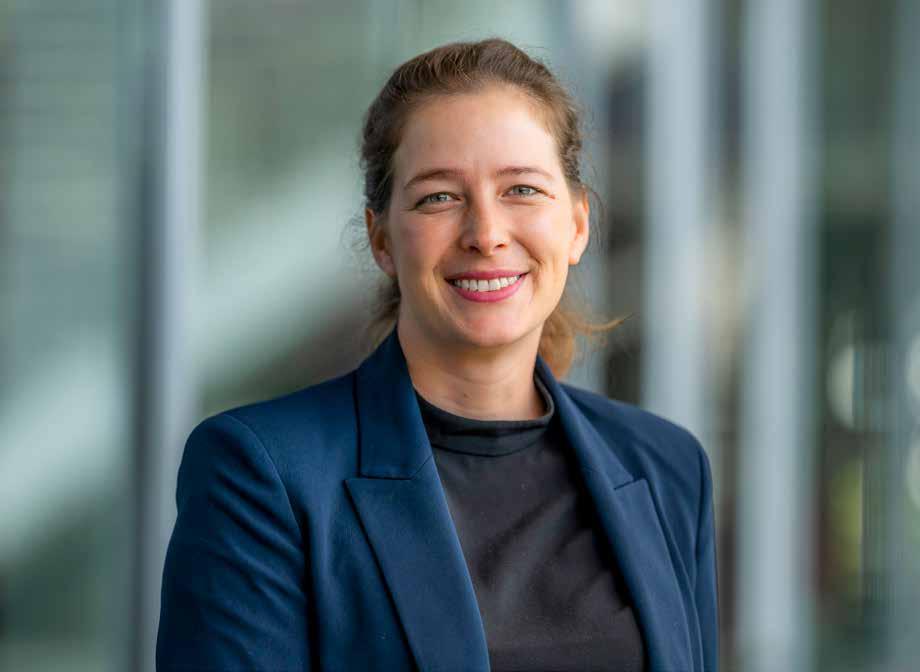
Sarah Brüningk, ETH Zurich, Switzerland
In clinical studies involving spinal cord injuries, it is crucial to correctly assess and predict healing progress. Both the health condition of the affected individual and the specific characteristics of the injury need to be considered. Swiss researchers hope to explore new approaches improving this process. They are utilizing state-of-the-art data analysis methods to evaluate data collected from thousands of patients. In future, artificial intelligence could be applied to create personalized treatment plans that significantly increase the success of clinical trials.
Artificial intelligence could be applied to create personalized treatment plans that significantly increase the success of clinical trials.
Alejandro ArrieroCabañero, National Hospital of Paraplegics, Toledo, Spain
Phagocytes serve as the body’s waste disposal system. One of their tasks is to remove cell debris after an injury. However, in the event of a spinal cord injury, their activity is inhibited by chronic inflammation. This means that harmful cell waste, such as

Alejandro Arriero-Cabañero, a Ph.D. student at the Hospital Nacional de Parapléjicos in Toledo.
destroyed nerve cell sheaths, is no longer disposed of. Scientists in Catalonia are now attempting to stimulate this recycling process biochemically. They harness so‑called synthetic retinoic acid receptor (RAR) agonists for this purpose. Their goal: a drug that eliminates waste, thus creating a foundation for nerve cells to regrow and form new sheaths.


Lennart Stieglitz, University Hospital Zurich, Switzerland
Following a spinal cord injury, some nerve connections usually remain intact – albeit too few to maintain bodily functions. This is where Swiss researchers come in. They hope to reactivate the remaining nerve pathways using electrical stimulation. Their study involves surgically implanting electrodes into the patient’s midbrain in order to selectively stimulate central control centers responsible for walking. This technique could significantly improve the recovery and mobility of those affected.
Rosa Laura Depau, King’s College London, United Kingdom
Two major factors hinder nerve growth following an injury: the limited ability of nerve fibers to regrow and complex growthinhibiting processes within the spinal cord. British neuroscientists are presently studying molecules that could overcome these blockages. Among them is Protrudin –a molecule that is designed to specifically promote the regeneration of damaged nerve fibers. In experimental models, it can be introduced into the spinal cord by means of gene therapy. The researchers hope that Protrudin can flip the switch for nerve growth there.

director of

Benjamin M. Segal, The Ohio State University, USA
Inflammation after an injury can be both beneficial and harmful: it either supports the healing process or damages surrounding tissue. US scientists hope to gain a better understanding of how different cell types respond to injuries. The focus lies on socalled “immature neutrophils,” a special type of immune cell. Derived from stem cells, they could protect dying nerve cells and promote the regrowth of severed nerve fibers. In the long term, this could eventually lead to a new therapy approach harnessing the patient’s own bone marrow immune cells.
Will
Cafferty, Yale University, New Haven, USA
Why is it so difficult for injured nerve fibers to sprout again? The detailed biological processes have barely been researched to date. US scientists, however, are currently studying the signaling pathways that control this particular process. Their objective is to determine how intensive rehabilitation activates certain genes that promote nerve growth – and which therapies could assist in this regard. Based on this knowledge, future rehabilitation programs could be improved through complementary therapies.

Jarred Griffin, The University of Auckland, New Zealand & Frank Bradke, DZNE, Bonn, Germany
Neuroscientists from Auckland and Bonn are developing a combination therapy comprising a targeted rehabilitation program and the administration of medications to significantly improve recovery following a spinal cord injury. The individual agents have already shown promising results in the laboratory. “Pregabalin”, for example, is deployed to protect nerve cells, “Epothilone B” is used to reduce scarring, and “antiNogo-A antibodies” to promote nerve fiber growth. If the researchers are successful, it could result in a clinical trial in the near future – and thus a new treatment approach for those affected.
Postdoctoral researcher Jarred Griffin (right) is working in collaboration with German scientist Frank Bradke, head of a research group at DZNE in Bonn.

Michael Kilgard, University of Texas, USA

This is news that we are particularly excited to share. The clinical trial conducted by Prof. Michael Kilgard from the USA has delivered impressive results. Participants suffering from chronic, incomplete cervical spinal cord injuries were able to significantly improve their arm and hand function. The approach involved a combination of intensive rehabilitation training and targeted electrical stimulation of the vagus nerve, which runs along the side of the neck. State-of-the-art closed-loop vagus nerve stimulation (CLV) entails inserting a tiny chip in the neck. Stimulation occurs wirelessly via a device that is worn around the neck like a collar and can therefore also be used conveniently at home via an app. This innovative therapy could be available in as little as a few years, providing many patients with improved independence and quality of life. A more extensive approval study is currently in preparation. Wings for Life has supported the preceding project and the clinical study from the beginning with a total of 1.3 million US dollars.
Your donation makes all the difference – and helps to facilitate research like that of Prof. Michael Kilgard. Together we will make spinal cord injury curable.
What if no dataset was ever lost? These two scientists are making research findings accessible and usable – for everyone.
Laboratories around the world generate innumerable volumes of data every year, yet much of this valuable research remains untapped – quietly disappearing into a filing cabinet. What if all that data were freely accessible and scientists could work with it collaboratively? This is precisely the vision that researchers Adam Ferguson and Karim Fouad are pursuing with their “Open Data Commons” platform. In this interview, the two pioneers discuss their vision of revolutionizing science.
What inspired the idea of an open data platform?
Karim Fouad: Over the course of my career, I have repeatedly observed that a lack of transparency tends to slow down research. This has, at times, raised doubts in my mind about how meaningful our models really are. The turning point arrived when I encountered Adam at the Wings for Life Summer School 2014, where he demonstrated how large-scale data analyses can provide new insights. I then realized how this approach could advance the entire field of research.
Adam Ferguson: The issue in biomedicine is that we still rely
heavily on scientific publications, even though the modern world is largely driven by data. We have so far barely mastered the task of systematically managing and sharing this data. This is why we – with the support of Wings for Life, among others – have developed the Open Data Commons platform. It allows us to pool data, promote open exchange, and thus accelerate research.
Why is it not yet standard scientific practice to share data?
Adam Ferguson: Researchers at universities are not incentivized to share data, but to publish. If you
Karim Fouad and Adam Ferguson (right) together at the Wings for Life Scientific Meeting.

merely cultivate data rather than publishing it, you risk jeopardizing your career. Survival in science still hinges on publishing.
Karim Fouad: Sharing data is time-consuming, resource-intensive, and requires a cultural shift. Many researchers are cautious for fear others may use their data or question their conclusions. In many cases, the effectiveness of data management is insufficient. Once these structures are improved and the scientific culture becomes more transparent, data sharing could become a natural part of the research process.
Why is open data exchange so essential?
Adam Ferguson: Scientific publications are a mere interpretation of data, whereas raw data contains the truth. By combining them with other data sets and modern analysis tools, they can provide completely new insights and accelerate discoveries.
Karim Fouad: Positive results are often the only ones published. If, for example, five research groups test the same treatment, but only two publish positive results, important information is lost. Sharing all the data – including negative
“Data sharing will accelerate discovery and provide a transparent view on research.”
Karim Fouad
The two researchers from Canada and the USA share a longstanding collaboration.
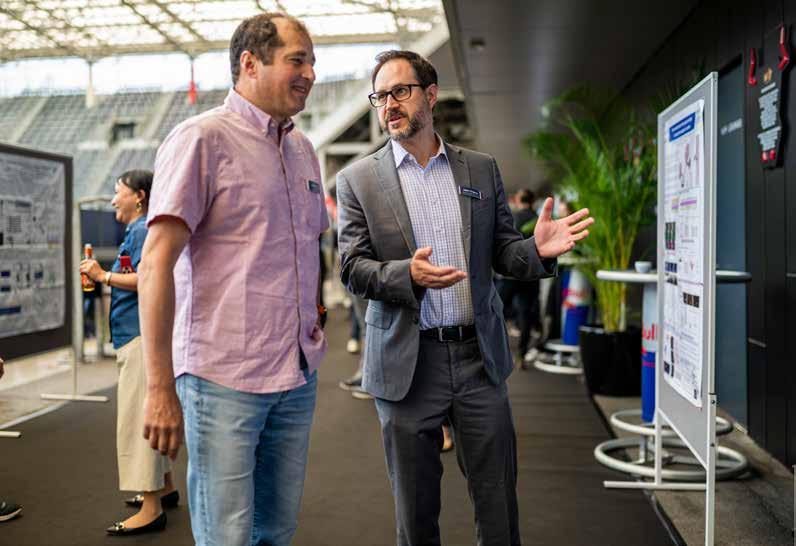
results – avoids wasting time and resources while opening up new possibilities. Open data sharing is long overdue, especially in spinal cord research.
Will data extracted from clinical studies also be incorporated in the future?
Adam Ferguson: The platform already contains many clinical data sets. Data can be uploaded by anyone willing to do so. The platform is evolving into a tool for data-savvy talent worldwide. Our hope is that an increasing number of specialists will access the data and develop innovative solutions.
Karim Fouad: Exactly. Our goal is for the platform to grow into the central resource for spinal cord injury – a space for collaboration and
exchange. We are already integrating preclinical and clinical data and endeavor to further expand this approach. In the long term, we would like to involve neighboring research areas in order to accelerate the development of new therapies.
“By combining data sets with modern analysis tools, they can provide completely new insights.”
Adam Ferguson
What are the most challenging hurdles?
Karim Fouad: The pressure on researchers to consistently deliver new and spectacular results is immense. This not only discourages replication studies but also makes it difficult to share complete data sets – especially when the results are negative. We are striving to change this academic culture. This might also require new funding models that specifically support open science.
Adam Ferguson: Even profit-orientated private companies reach their limits because they cannot afford to wait 20 years for results. Open databases allow us to overcome these hurdles. If we share data, we can achieve much faster progress in the future.
How does your “long-distance relationship” across the borders of the USA and Canada function?
Karim Fouad: Naturally, it would be more efficient to sit in the same room from time to time. Yet, surprisingly, the distance has been beneficial. Our twice-weekly virtual meetings are easier to organize than face-to-face meetings. Working in different countries has expanded our perspective and broadened our network. I distinctly remember the whole team working together on a live document – it almost felt like magic. It was efficient, collaborative, and fun.
Which developments would you like to witness in spinal cord research?
Adam Ferguson: Spinal cord injuries are complex and involve many different factors. I would like to see data shared completely and transparently. This would allow us to develop personalized therapies and provide more personalized treatments. We currently lack the necessary data and tools to do so.
Karim Fouad: I would like to see research continue in line with the highest scientific standards – with rigorous planning, transparency, and a keen awareness of the importance of preclinical work. Yet the field should be even more collaborative, with a focus on gaining knowledge for the benefit of all.

Specializes in neurotraumatology, particularly in the field of spinal cord injuries, at the University of California, San Francisco (UCSF), USA. He is Co Director of the Brain and Spinal Injury Center (BASIC) in the UCSF Weill Institute for Neurosciences and conducts research at the interface of neuroscience and data science.

Prof. Dr. Karim Fouad
Is a renowned researcher in the field of neurorehabilitation and nervous system regeneration. His expertise includes functional outcome measures, electrophysiology, anatomy, neuroplasticity, and regeneration. He holds a Canada Research Chair (Tier 1), a prestigious, federally funded professorship in Canada awarded to outstanding researchers.
iOPEN DATA COMMONS FOR SPINAL CORD INJURY (ODC-SCI)
is a digital platform created by researchers for researchers. It facilitates the uploading, sharing, and free use of preclinical and clinical data. The objective is to make knowledge openly accessible and research results utilizable on a global scale. The database, which is already in operation, is being continuously advanced. It is supported by Wings for Life, among other organizations.

They both agree: knowledge must be much more accessible in the future.
How do you interact with people who have a spinal cord injury? You may feel insecure even though there really is no need to.
Interaction requires neither medical expertise nor specific rhetoric, just openness, empathy, and respect. Wolfgang Illek shares five useful pointers from the perspective of someone affected.
Communicate at Eye Level
When talking to each other, people tend to look each other in the eye – preferably at the same level. For longer conversations, simply sit down next to the person. And please always address the individual concerned directly; don’t talk over them.
It is perfectly acceptable to talk about wheelchairs or medical issues, provided that those affected bring the subject up themselves. Common topics of conversation, such as your new favorite TV show or where to find the best coffee in town, are often better for bonding. The focus should be on the person, not the diagnosis.
Please Ask Before You Help
Offering help is a wonderful gesture, but it is not always welcome.
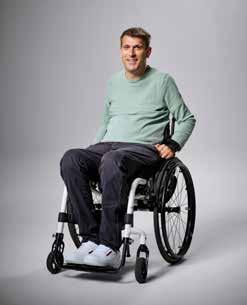
“I don’t feel confined to a wheelchair – it affords me mobility and a certain degree of independence.”
Wolfgang Illek, Head of Fundraising at Wings for Life
A friendly “May I help?” allows the other person to decide for themselves. Wheelchairs and walking aids are personal items, much like a handbag or backpack. They
should not be touched without permission. In the worst-case scenario, a wrong move or incorrect handling of a wheelchair can even be dangerous for those affected.
Overcoming Barriers Together
Stairs, narrow doors, or a lack of ramps complicate everyday life for people in wheelchairs. If you spot potential barriers, please point them out. In many cases, this is enough to ensure that everyone arrives at their destination in a relaxed manner.
Exaggerated admiration and phrases along the lines of “You’re doing great regardless” can cause embarrassment. Let’s be honest, who wants to be elevated to a pedestal constantly? Equally, not everyone in a wheelchair is unhappy or desires pity. Many wheelchair users don’t perceive a wheelchair as a limitation, but as a means of mobility and self-determination.

















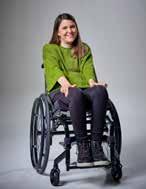






INTERNATIONAL Bankhaus Carl Spängler & Co, Salzburg, IBAN: AT27 1953 0001 0001 1911 BIC: SPAEAT2S
Beneficiary: Wings for Life – Spinal Cord Research Foundation, Fürstenallee 4, 5020 Salzburg, Austria UNITED KINGDOM HSBC, Account Number: 80077577 Sort Code: 40-11-60 IBAN: GB11HBUK40116080077577 BIC: HBUKGB4194R, Beneficiary: Wings for Life, Seven Dials Warehouse, 42–56 Earlham Street, London WC2H 9LA, UK USA Wells Fargo Bank NA, Account number: 4555650969 Routing transit number: 121000248 SWIFT No: WFBIUS6S



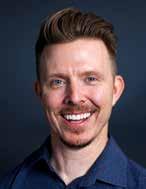
Beneficiary: Wings for Life USA – Spinal Cord Research Foundation Inc., 1630 Stewart Street, Santa Monica, CA 90404 100% ALL DONATIONSGUARANTEE